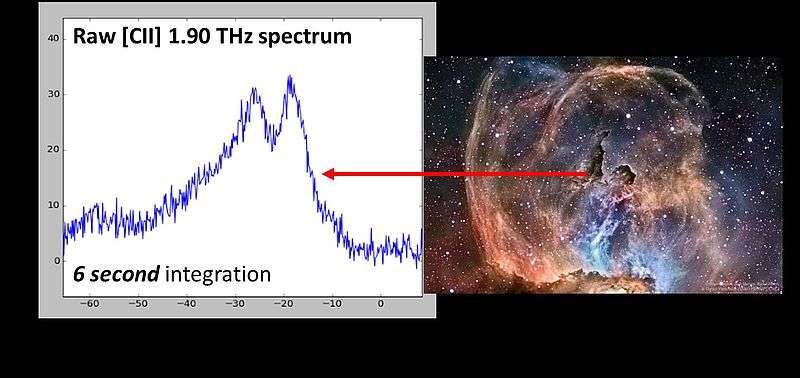STO2 landed and data secured

The STO2 telescope with Dutch detectors on board that circled around the South Pole in December 2016 to investigate gas clouds between the stars landed safely on 30 December.
At an altitude of 39 kilometers the NASA telescope circled along with the polar vortex for a period of three weeks. During that time STO2 picked up as much radiation as possible at the frequencies of 1.4 and 1.9 THz to find ionized nitrogen (NII) and ionized carbon respectively (CII) in a part of our Milky Way. These substances indicate the process of star formation from dust and gas.
Measuring oxygen
The 4.7 THz detector that would measure neutral atomic oxygen (OI) also worked. However, something went wrong in the system for the local oscillator that had to generate the required reference signal of 4.7 THz. An electrical component needed for the communication between this local oscillator and ground control became overheated by the sun. OI reveals that a star is actually being born. This is an observation that astronomers are keen to obtain, especially if that observation is being done for the first time beyond the earth's atmosphere, as would have been possible with STO2.
STO2 project leader for SRON and TU Delft researcher Jian-Rong Gao and his team are indeed disappointed about the absence of the 4.7 THz observations but on the other hand they are extremely happy with the large quantity of data for the other two frequencies. After an initial hiccup in the orientation mechanism of the telescope, the collection of that data proceeded really well. "Once the rough data have been processed to reveal spectral lines for CII and NII then STO2 will have drastically expanded the area mapped so far for these substances."
Mission continues
STO2 was launched from Antarctica on 9 December 2016. The polar vortex also ensures that the balloon missions land again at a location that can be reached along the South Pole Traverse, a sort of Antarctic 'motorway' between the South Pole and McMurdo. When the cooling fluid for the superconducting detectors (liquid helium) had been used up and the data was safely downloaded to computers on earth, STO2 landed on the South Pole Transverse. The telescope was picked up on 10 January so that it could be brought back to McMurdo.
STO2 is an exploratory mission under the leadership of the University of Arizona for astronomy in these terahertz frequencies. On 24 January 2017, NASA will visit the University of Arizona to decide about GUSTO. This is also a balloon mission but with a longer duration (about 100 days) and with more effective instruments on board. For NII, CII and OI, GUSTO will have cameras with eight pixels that will once again be developed by SRON and Delft University of Technology.
The teams of professor Alexander Tielens (Leiden University) and professor Floris van der Tak (SRON/University of Groningen) will contribute to the scientific analysis of the observations.
Provided by Delft University of Technology





















